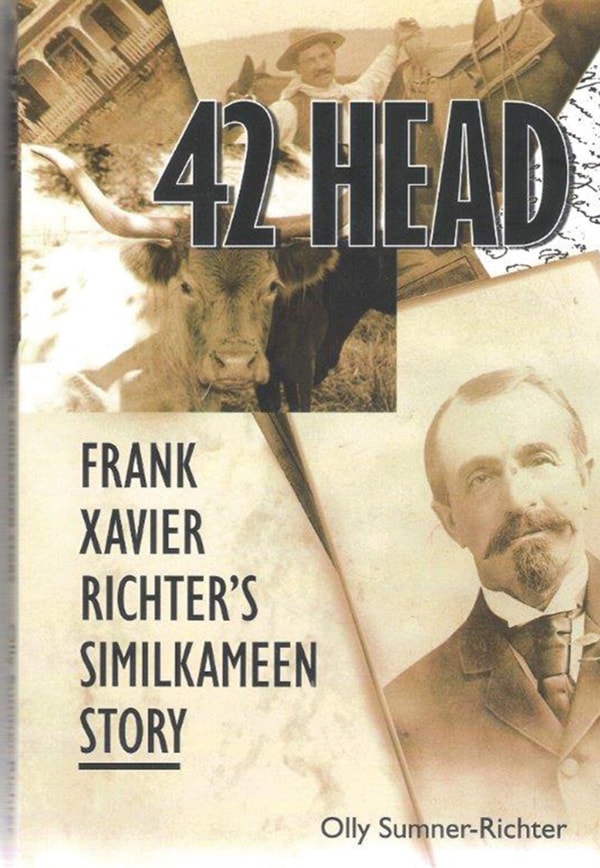One of the first European settlers in the Similkameen launched his family’s dynasty by arriving in the valley with a herd of 42 cattle.
The book, 42 Head, outlines the story of Frank Richter, who at 19 first landed as a stowaway on a ship in Galveston, Tx. Richter by definition was a refugee, fleeing his European home (in the modern day Czech Republic) which was situated in a highly contested part of the continent.
“He came from a country that was knocked around politically,” said Olly Sumner-Richter, Frank’s great-granddaughter who recently wrote the book about his life.
Richter had been hired by the U.S. cavalry at the beginning of the Civil War as a scout by the Confederate Army, though he maintained a civilian status.
“He wasn’t sure what he wanted to do but for sure he knew he didn’t want to be in the army,” said Sumner-Richter. “His job was to go ahead of the army to locate Indian settlements and find the most efficient routes to take. The cavalry wanted him to stay on longer but he’d had enough of that.”
Through his work with the Confederate Army, and subsequent time in the mining industry, Richter steadily made his way north.
“He moved his way up the California coast and was trying, as many others were, to hit it rich with the gold rushes.”
After hearing rumours of a rich and promising land in Canada, Richter first arrived in the Similkameen in 1864.
Richter set out on his goal of becoming a cattle farmer along with his partner Mr. King, who is believed to have sold him on the idea of settling in the Similkameen. Entering Canada through the Osoyoos border crossing, with their 42 head, their entrance into the country was documented by the bill they paid to clear customs. Sumner-Richter said the pair arrived in the Similkameen to find “the bunch grass as high as the saddles.”
Richter homesteaded in Cawston and recognized that the success of his farm would depend upon a healthy relationship with nearby aboriginal communities.
“He wasn’t familiar with the land, the seasons or the local trails, so he figured it out pretty quick that he needed their expertise.”
Sumner-Richter said her great-grandmother Lucy Simla, who was a member of the Head of the Lake band (Okanagan Nation Alliance), was instrumental in securing that strong relationship with the local natives.
“She must have been the link between him and the aboriginals, and certainly contributed to his success in this regard.”
Richter could navigate the region, at that time, only by trails on his horse, and among the routes mapped out by the aboriginals and Hudson Bay Company; many of the trails he frequented have since developed into our present highways. Sumner-Richter said her book offers a map which details three horseback routes into Penticton from the Cawston area.
Richter went on to have five sons with Lucy; two of which married white women and the other three married women of aboriginal origin. For reasons that aren’t fully understood, there was a disconnect in the family.
“I didn’t know about that other side, so when I started researching and got to know other members of the family it was truly amazing what I found out. They wouldn’t have known me from a hole in the wall because of the separation in the family, but now these are relatives who I’ve grown to care about in a real special way.”
Upon reaching out, Sumner-Richter was surprised to find her relatives were in possession of even more of her great-grandfather’s records than her family was.
“I was surprised to learn how methodical he had been. It definitely contributed to his success.”
After years of hearing many falsehoods about her great-grandfather (namely that he was born into wealth), Sumner-Richter began researching Richter’s history in order to compile a “historical social document”. Without dramatizing her great grandfather’s story, she finally, after over 10 years, released her work in November as a book entitled 42 Head Frank Xavier Richter’s Similkameen Story.
Frank Richter prospered as an entrepreneur in the Similkameen before dying in 1910 as a wealthy man. His accomplishments are well-documented in 42 Head and the book serves as a tribute to the influence he had in the Similkameen.
Copies of 42 Head can be found for purchase at the Grist Mill and Gardens at Keremeos, the museums in Oliver and Osoyoos, Books N’ Things in Penticton, Beyond Bliss in Oliver and Keremeos Pharmasave.
